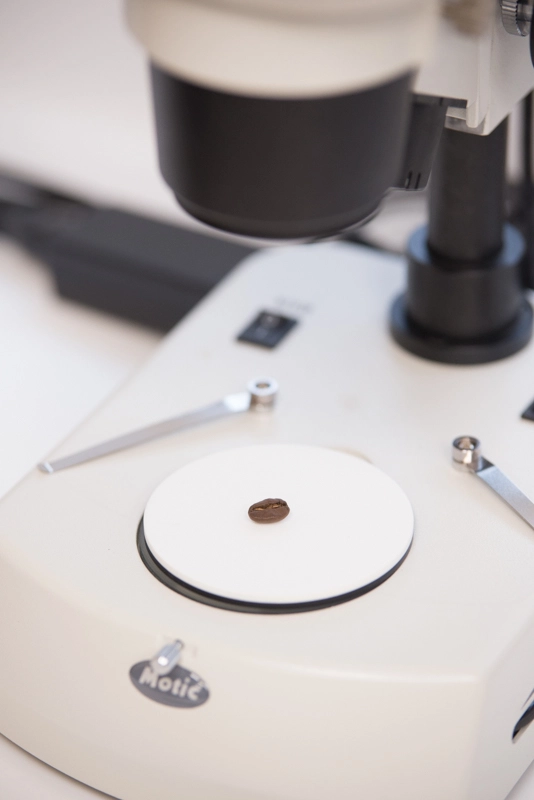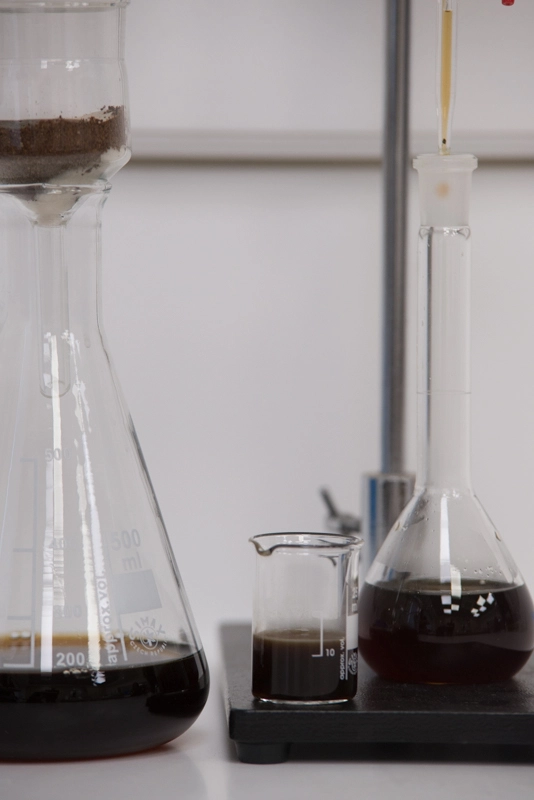


Our coffee offerings enable each business that we work with to develop a unique taste profile that will set them apart from the competition and help make their brand unique. With the assistance of our experts, choose from three distinct options the level of premium coffee and customization that is best suited to your brand.
Making exceptional coffee is an art – that needs to be grounded in the science of roasting. This is the guiding principle of QU, and the reason why we invest in state-of-the-art equipment, monitor the latest developments in the coffee roasting industry, develop and incorporate new processes, all to continuously improve the quality of our coffee.







At QU, we invest a lot of time, effort and significant funds in applied research and development, because we believe that this is the engine of our innovation process. Our expert team of researchers in collaboration with universities and foreign experts, offer comprehensive technological analysis and advice with emphasis on quality, food safety and new product design, allowing the company to stay ahead of its competition. A series of scientific research programs, conducted under the auspices of Aristotle University of Thessaloniki (Dept. of Chemistry – Laboratory of Food Chemistry, and School of Geology – Dept of Mineralogy-Petrology-Economic Geology), and fully funded by the QU parent company, are currently in progress or have been completed.

Chemical analysis by gas chromatographic separation of different roasted coffee samples, was investigated. Identification of volatile organic compounds and comparison with Amdis, Chemstation and bibliographic source mass spectra libraries, was examined.

We extensively characterized the multilayer packaging material with spectroscopic analysis. At the same time, thermogravimetric analysis and study of its tensile and mechanical strength, was carried out with the aim of organoleptic quality.

Serial backscattered electron photographs, were taken and all physicochemical changes observed during roasting inside and outside the coffee beans, were visualized.

Commercial samples of animal and vegetable milk were characterized in terms of their composition in proteins, chemical components and surface activity. Denaturation of the proteins, was extensively investigated in order to examine their influence in the formation and stability of the foam bubbles.

The aim of the examination, was the kinetic release of carbon dioxide from roasted beans of different origin and different roasting profiles, packaged or not, grinded or not. Mathematical models and standard curves were examined in order to check their verification.

Differently structured multilayered or non-multilayered, different polymeric packaging films will be examined in terms of their ability to preserve unaltered the volatile and organoleptic organic compounds of roasted coffee samples.

Differently structured multilayered or non-multilayered, polymeric packaging films, will be studied in terms of their permeability, migration properties, delamination and durability.

Chemical composition of different processing raw coffee beans, was studied in terms of proteins using the Kjeldahl method, of fat by the Soxhlet method, and total sugars colorimetrically showing a clear discrimination of the selection of processing method.





The success of your coffee shop will depend on many different factors, but the quality of the coffee and the skills of your staff are at the top of the list. We believe that being a barista is a vocation – a demanding one, so we design specialized barista training. Our dedicated team of SCA Certified Barista Trainers, with long career experience and broad coffee knowledge, deliver quality courses that will transform your staff’s performance. Our training courses are enriched with input from our R&D department and its collaborations with academic researchers. Our training curriculum is informed with the findings produced by our QU scientific research team – our way of sharing the knowledge. A course at our Academy will prepare your staff to deliver excellent coffee and exceptional service.
Choosing a partner for your business should be about more than products and prices. Our goal is to help our partners grow and succeed. Before you even place a coffee order, we will provide customized consultation to help you make the best choices. You will have full technical assistance for your coffee-making setup, plus quality control of your coffee-making processes and equipment. We care about every detail: we carry out quality controls on your water supply, both at the pre-sales stage and during the post-installation quality audit. Technical support is provided by the Qualita Unica scientific research team, based on their extensive experience and knowhow. And you can build the best barista team with the staff training programs at our Academy, delivered by our dedicated SCA Certified Barista Trainers. We believe in giving you the tools to succeed and providing the support you need to elevate your service offering and build a strong customer base.
The “Coffee Belt” lies between the tropic of Cancer and the tropic of Capricorn and includes countries in Africa, Asia, and South America, which are the largest producers of coffee in the world. Each coffee-producing country and region has distinct characteristics that give its coffees unique flavor qualities.

About one-third of all of the world's coffee is grown in Brazil – in the main coffee-producing regions of Minas Gerais, Espirito Santo, São Paulo and Bahia. Coffee is grown at elevations of 600-1300 m above sea level, and it is harvested primarily from May to August. The botanical species are 70% Arabica and 30% Robusta, and the genetic varieties include Acaia, Bourbon, Mundo Novo, Catuaí, Catucaí, Catigua and Topazio. Processing methods include natural drying, pulped natural, honey, and fully washed. The cupping profile for Brazilian coffees includes all kind of nuts, caramel, apple, toffee, molasses, raisin, spice, and honey, a viscous body and mild acidity
The "Coffee Cultural Landscape" of Colombia has been declared a World Heritage site by UNESCO. Coffee is grown mainly in the regions of Antioquia, Cauca, Cundimarca, Huila, Nariño, Santander, and Tolima, at elevations of 1200-2000 m above sea level, and it is harvested primarily from March to June and from September to December. The botanical species is Arabica, and the genetic varieties include Caturra, Colombia, Castillo, Typica, and Bourbon. The primary processing method is washed. The cupping profile for Colombian coffees includes woody spicy and toasted notes with nutty hints, a gentle brightness and moderate body
Costa Rica is the only country in the world where it is illegal to produce anything less than 100% Arabica coffee beans! Coffee is grown mainly in the regions of Tarrazú, Brunca, Guanacaste, West Valley, Central Valley, Turrialba, and Orosi, at elevations of 600-1300 m above sea level, and it is harvested primarily from November to April. The botanical species is Arabica, and the genetic varieties include Mundo Novo, Villa Sarchi, Catuai and Caturra. The processing methods include fully washed, pulped natural, and natural. The cupping profile for Costa Rican coffees includes all kind of nuts, hints of caramel and pineapple, notes of vanilla and chocolate, a mild acidity and spicy aroma.
Traditionally, coffee has provided more than 50% of El Salvador’s export revenues. The country’s main coffee-producing regions are the Apaneca-Ilamatepec Range, the Alotepeque-Metapan Range, El Balsamo, and Chinameca. Coffee is grown at elevations of 1200-1500 m above sea level, and it is harvested primarily from November to April. The botanical species is Arabica, and the genetic varieties include Bourbon, Pacas, Pacamara, and a Tekisic-Bourbon hybrid. The processing methods include washed, pulped natural, and natural. The cupping profile of Salvadoran coffees includes spicy fruity notes such as apple and toasted pop-corn notes, with a gentle brightness and moderate body.
For many, Ethiopia is considered the birthplace of coffee – some experts say it is the only place where coffee grew natively. The country’s main coffee-producing regions are, in the South, Sidamo, Yirgacheffe, and Guji; in the East, Harrar; and in the West, Limu, Kaffa, Agaro, and Ilubabor. Coffee is grown at elevations of 1800-2200 m above sea level, and it is harvested primarily from November to March. The botanical species is Arabica, and the genetic varieties include Heirloom and Typica. The main processing methods are washed and natural. The cupping profile of Ethiopian coffee includes spicy bouquet notes, citrus and lemongrass notes, a sparkle brightness and medium body
Coffee in Guatemala is grown at very high altitudes of 1300-2000 m above sea level, giving it its robust and distinctive flavor. The main coffee-producing regions in Guatemala are Huehuetenango, Antigua, Atitlan, Fraijanes, and Cobán. The harvest is from November to April. The botanical species are Arabica and Robusta, and the genetic varieties include Bourbon, Caturra, Catuai, Catimor, and Maragogype. The primary processing method is washed. The cupping profile of Guatemalan coffee includes woody, spicy, and buttery-caramel notes with nutty hints, a gentle brightness and viscous body.
Honduras is one of the few coffee-producing countries that have the capacity to grow more, increasing its potential. The main coffee-producing regions are Copan, Santa Barbara, Marcala, Ocotepeque, El Paraiso, Comayagua, Opalaca, and Montecillos. Coffee is grown at elevations of 1400-1800 m above sea level, and it is harvested from November to June. The botanical species are Arabica and Robusta, and the genetic varieties include Catuai, Pacas, Bourbon, Caturra, and Typica. The primary processing method is washed, with some pulped natural and natural. The cupping profile of Honduran coffee includes notes of vanillin, butter caramel, nuts, spicy toasted notes, and sherry, with moderate brightness.
Coffee in India is grown under a canopy of thick natural shade in ecologically sensitive regions and contributes significantly to sustain the unique local biodiversity. The country’s main coffee-producing regions are Karnataka, Kerala, and Tamil Nadu. Coffee is grown at elevations of 1100-1400 m; Arabica species are harvested from November to February, while Robusta species are harvested from January to March. The genetic varieties include S.795, Catimor, San Ramon, Caturra, and Devamachy. The processing methods used are washed, natural and monsooned. The cupping profile of Indian coffee includes spicy flavors and notes of pepper, cardamon, and peanuts, and a full body with moderate though distinct acidity.
Jamaica is the home of Blue Mountain, possibly the most sought-after type of coffee in the world! The main coffee-producing region is, of course, Blue Mountain (Saint Andrew, Saint Thomas, Portland, and Saint Martin). Coffee is grown at elevations of 900-1700 m above sea level, and it is harvested from January to February. The botanical species is Arabica, and the genetic varieties include Typica, Caturra, and Geisha. The processing method used is washed. The cupping profile of Jamaican coffee includes hints of nuts, floral and chocolate, with a well-balanced, full body and sweet flavor.
The coffee industry of Kenya is noted for its cooperative system of production – about 70% of Kenyan coffee is produced by small holders The country’s main coffee-producing regions are Nyeri, Kiambu, Kirinyaga, Embu, and Machakos. Coffee is grown at elevations of 1600-2000 m above sea level, and it is harvested from October to January. The botanical species is mainly Arabica with very little Robusta, and the genetic varieties include SL28, SL34, Ruiru 11, and Batian. The processing methods used are mostly washed, with some pulped natural and natural. The cupping profile of Kenyan coffee includes notes of fruit, mixed berries, spice, cocoa, and toffee, with a full and intense body.
Arabica grows particularly well in the southern coastal regions of Mexico, near the border with Guatemala. The country’s main coffee-producing regions are Veracruz, Puebla, Oaxaca, and Chiapas. Coffee is grown at elevations of 1000-1800 m above sea level, and it is harvested from November to March. The botanical species is mainly Arabica with very little Robusta, and the genetic varieties include Bourbon, Mundo Novo, Catura, and Maragogype. The processing methods used are primarily washed, with some natural. The cupping profile of Mexican coffee includes spicy woody notes, sandalwood, honey, pineapple-vanillin, with a gentle brightness and medium body.
Coffee production has been an important part of Nicaragua’s history and economy since the 1850s. The country’s main coffee-producing regions are Nueva Segovia, Matagalpa, Madriz, and Jinotega. Coffee is grown at elevations of 1200-1800 m above sea level, and it is harvested from November to April. The botanical species is Arabica, and the genetic varieties include Catuai, Caturra, Bourbon, Maragogype, Maracaturra, Pacamara, and Catimor. The processing methods used are washed, with some pulped natural and natural. The cupping profile of Nicaraguan coffee includes sugarcane, caramel, plum, and a hint of fruit notes, with a medium body.
In Panama, the main coffee-producing regions are Boquete and Chiriqui, and local indigenous groups living there are dependent on coffee production for their sustenance. Coffee is grown at elevations of 1100-1700 m above sea level, and it is harvested from December to May. The botanical species is Arabica with very little Robusta, and the genetic varieties include Bourbon, Caturra, Catuai, Typica, and Geisha. The processing methods used are washed, with some pulped natural and natural. The cupping profile of Panamanian coffee includes a jasmine-like aroma, notes of berries, papaya, mandarin, and bergamot, and a light body.
In Papua New Guinea, production is largely by small farmers with tiny land holdings predominantly in isolated places, so the product is mostly certified as “organic coffee”. The main coffee-producing regions are the Waghi Valley, the Eastern Highlands, and the Chimbu Valley. Coffee is grown at elevations of 1580-2200 m above sea level, and it is harvested from February to September. The botanical species is mostly Arabica with some Robusta, and the genetic varieties include Typica, Bourbon, Arusha, Blue Mountain, and Catimor. The processing method used is washed. The cupping profile of New Guinean coffee includes a spicy bouquet of notes, including apricot, rose, honey, and butter caramel, with a moderate and elegant brightness.
Although Peru is one of the larger coffee producers (and exporters) globally, the country’s coffee consumption is pretty low! The main coffee-producing regions are Chanchamayo, Amazonas, and San Martin. Coffee is grown at elevations of 1100-2000 m above sea level, and it is harvested from August to October. The botanical species is Arabica, and the genetic varieties include Typica, Bourbon, Catimor, and Caturra. The processing method used is washed. The cupping profile of Peruvian coffee includes spicy floral notes, citrus notes, tobacco, and vanillin, with a gentle brightness and moderate body.
In Rwanda, coffee trees are an integral part of the landscape, and coffee is the main source of income for many families. The country’s main coffee-producing regions are Lake Kivu and Butare. Coffee is grown at elevations of 1200-1900 m above sea level; the main crop is harvested from May to August, and the fly crop in October. The botanical species is mainly Arabica, and the genetic variety is predominantly Bourbon. The processing method used is washed. The cupping profile of Rwandan coffee includes sugarcane, cinnamon, rose floral aromas, and a full creamy body.
Coffee was introduced in the region of present-day Tanzania as early as the 16th century, but it was used as a stimulant. The country’s main coffee-producing regions are, in the North, Moshi, Arusha, and Karatu; in the South, Mbinga, Mbeya, and Iringa; and in the West, Kigoma. Coffee is grown at elevations of 1400-1800 m above sea level, and it is harvested from August to December. The botanical species are Arabica and Robusta, and the genetic varieties are Bourbon, Kent, and Arusha. The processing methods used are fermentation washing, washed, and full natural. The cupping profile of Tanzanian coffee includes notes of sweet berry and a fruity citrus flavor, winey acidity and rich flavor of black currant and chocolate; the body is syrupy to full.
In Uganda, Arabica coffee is mainly grown under shade trees that ensure sustainable production – the leaves that fall from the shade trees provide manure for the coffee plants. The country’s main coffee-producing regions are Mount Elgon, West Nile, and the Rwenzori Mountains for Arabica, and the Central Lowlands for Robusta. Coffee is grown at elevations of 1300-2200 m above sea level. The western main crop is harvested from September to November (fly crop from March to May), and the eastern main crop is harvested from October to March (fly crop from June to July). The botanical species are Robusta and Arabica, and the genetic varieties are Typica, Kent, and SL28. The processing methods used are natural and washed. The cupping profile of Ugandan coffee includes strawberry, watermelon, chocolate, almond butter, and tobacco, with a heavy body and moderate acidity.